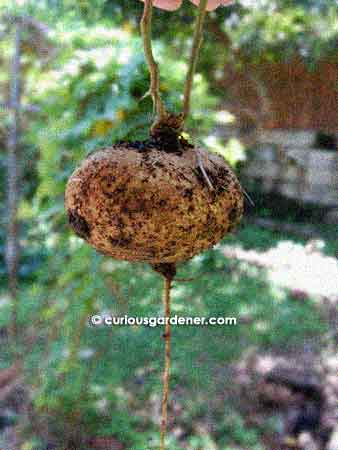Last year, I wanted to try growing the turnip-like bangkwang – also known as jicama or the yam bean. To get that going, I bought a small tuber from the wet market that still had a fresh-looking stem attached. I planted it, and it grew and flowered, giving me seeds that I then planted (or in a couple of cases, were dispersed by the explosive action of the seed pods). The plants have been growing for over a year now.
Earlier in June, I discovered that the plants had indeed been producing tubers – one tuber each, to be precise. It was so exciting to actually see what is meant by a “tuberous root”. (Have I not already admitted I’m a Doubting Thomas? Seeing is believing!)
Since then, it’s been a matter of waiting while the tubers grew…
Over this last weekend, I realized that the bigger of the two known tubers was peeking out at me. Maybe the heavy rain we’ve been having eroded the soil to expose the tuber.
Whatever the case, I decided to harvest it, finding that it had almost tripled in size since I last peeked at it. It was now about 14cm wide, with nice smooth skin and a thin, long tap root that didn’t give resistance when I pulled it out. Like all our other home-grown veggies, this was incredibly sweet to the taste! We must grow more…
© 2011 curiousgardener.com All rights reserved.


Congrats on your many harvests!
I’m curious though – when people in Singapore (who have the land to grow large plants) say that home-grown food is sweeter, do they/you mean that the taste really is sweeter? Or it’s sweeter because one took the effort to grow and harvest it?
I ask it because I know that Singapore’s rain is acidic, and that acidity actually causes plants and fruits grown here to taste bitter. So…
Thanks, Sky
I’m probably biased (LOL) but it really, literally tastes sweeter! It’s probably because our edibles are organically grown and the time from harvest to table is hours instead of days during which the sugars break down, etc. I guess the best thing to do is a comparison…
I think no gardener who grows her own stuff and consumes them (even on a semi-regular) basis will ever not be biased. But it’s a good bias which comes from hard work and effort put in. So…
But it’s a good bias which comes from hard work and effort put in. So… 
And hee. If you do do a comparison, let me know k? So funfun. =D
I will. It will be a while before the next tuber grows sufficiently, though. It was pretty small back in June when I peeked at both.
It will be a while before the next tuber grows sufficiently, though. It was pretty small back in June when I peeked at both.
I really enjoy your daily episodes. Well done. By the way I think your long green beans are also called Asparagus beans.
Glad you’re enjoying the blog, Mike. I started it more as an online journal for myself, but it’s turned out to be a great means of communication with other gardeners.
Thanks too for the additional name for the long beans. It wasn’t until I started writing about our plants that I realized how many names there are for the same things! Take for example this post – we’ve always called this veg “bangkwang” but other people, depending on their cultural backgrounds, have their own names for it. For simplicity (for myself), I just stick to what we call it, or I may toss in the common names for people who may be searching online. It’s a compromise.